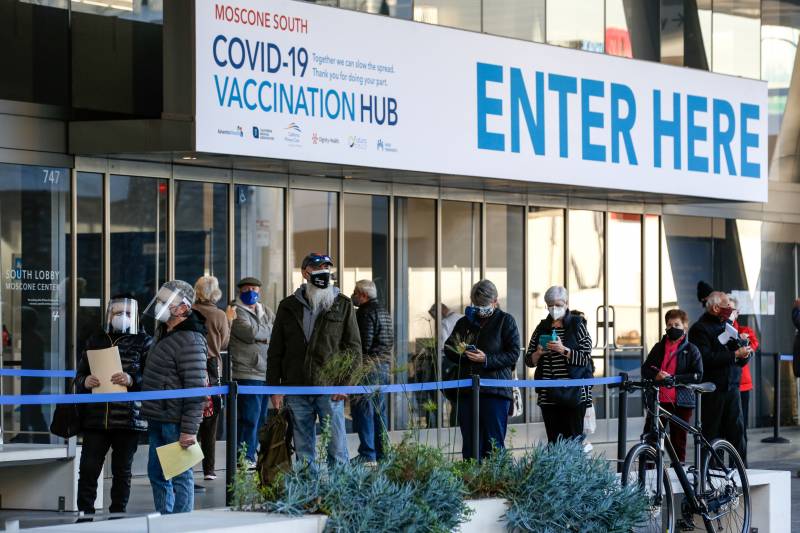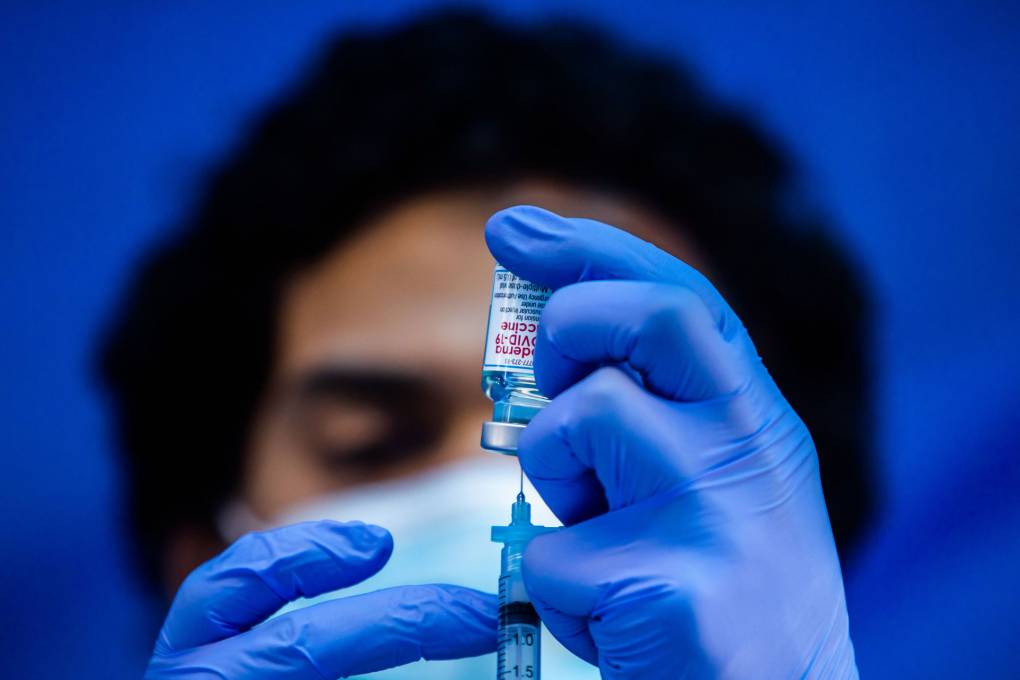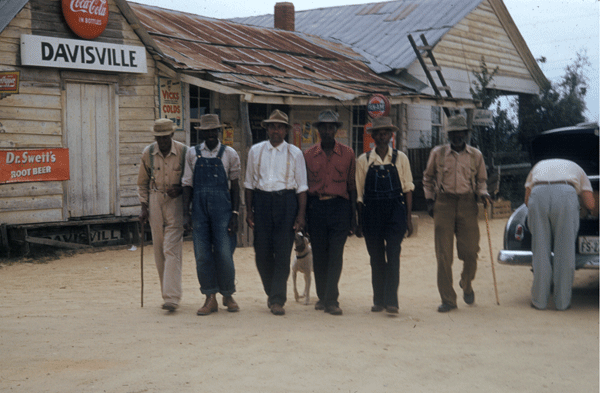Q: How do people know the vaccines are safe and effective?
Pfizer, Moderna and Johnson & Johnson conducted full trials and didn’t skip any steps in the stages of testing for the vaccines’ safety and efficacy. The stages included testing in animals and an application for FDA approval to test in humans. Then the drug companies tested the vaccine in a small number of individuals before conducting tests in tens of thousands of people.
The only part of this process that was shorter than usual was in how long drug companies observed people for long-term side effects before requesting FDA authorization to distribute the vaccine.
“They would normally wait, let’s say, six months after testing of the vaccine,” Wachter said. “They waited two months, and why? Because this was an absolute emergency and a catastrophe. And so in waiting extra months, there would have been hundreds of thousands of people that would have died.”
The FDA recently resumed the rollout of the Johnson & Johnson vaccine after a short pause to investigate incidents of a rare blood clot showing up in a small percentage of people in the U.S. who received this vaccine.
Experts say a pause like this is normal when a new medication or vaccine becomes available to the public, and does not indicate that the Johnson & Johnson vaccine is dangerous.
“The relative risk is really, really low for these severe blood clots,” said Dr. Catherine Blish, infectious disease specialist at Stanford Medicine after the initial reports. “So we’ve had the six cases out of almost seven million vaccines delivered, which is about one in a million. And while this has been hugely controversial, the birth control pills are associated with about one in 1000-100 rate of blood clots.”
The FDA was asking for a minimum of 50% efficacy against the coronavirus. After two doses, Pfizer-BioNTech’s vaccine is 95% effective at preventing the symptoms of COVID-19 and Moderna’s is a little over 94%.
Johnson & Johnson’s vaccine is about 77% effective in preventing severe/critical COVID-19 occurring at least 14 days after vaccination and 85% effective in preventing severe/critical COVID-19 occurring at least 28 days after vaccination.
Those results and the safety records are why the FDA authorized the emergency use of these vaccines.
Back to top
Q: What are the possible side effects of getting a vaccine?
The possible short-term side effects for all the vaccines include pain, swelling and redness at the injection site, as well as tiredness, chills and headaches. If you get side effects, they would typically start within a day or two of injection and last a few days. The side effects, experts note, are your immune system telling you the vaccine is working and your body is creating antibodies.
If you find yourself experiencing these side effects, consult your doctor before taking over-the-counter medication such as ibuprofen, aspirin, antihistamines or acetaminophen. Also, don’t take these medications before you get the vaccine.
The CDC reports that a December study found that a small fraction of people — 11.1 recipients per million doses administered — had a severe allergic reaction called anaphylaxis, which can be lethal. The CDC has listed a few allergies that could prevent someone from getting the vaccine. The agency also recommends people get screened for allergies before receiving the vaccine, and that vaccine sites have epinephrine injections available. If you have allergies, you may wish to consult your doctor about the vaccine.
There are two systems that allow you or your doctor to report any unusual side effects to officials at the CDC and elsewhere: V-safe and VAERS.
In the 15 cases confirmed by the CDC in which blood clots developed, it happened within three weeks after receiving the Johnson & Johnson vaccine. If you develop a severe headache, abdominal pain, leg pain, or shortness of breath within three weeks of receiving the vaccine, seek medical treatment with your health care provider or an urgent care clinic or hospital emergency room, and let the provider know you received the Johnson & Johnson vaccine.
Back to top
Q: But the FDA approved this vaccine after two months of observation; isn’t there a chance a really bad side effect could show up much later?
According to experts, says Wachter, in the history of vaccines there have been no instances of a serious, worrisome side effect that didn’t show up in the first two months. So while no one is saying it’s impossible for a long-term side effect to emerge later, both Wachter and Bibbins-Domingo say the risk of that is not even close to the risk of contracting COVID-19 and dying or ending up with long-term physical problems.
“It’s certainly not a close call, especially when you look at the surge in California, and also when you look at how much we really are still learning about how much the coronavirus affects the body,” said Bibbins-Domingo. “People should talk to their doctors, they should ask questions, but really the balance is in favor of getting this vaccine.”
While regulators don’t yet know whether there’s a link between the vaccine and the extremely rare cases of blood clots. If there is, it could be an example of the kind of thing that only occurs one in a million times. This type of case, then, typically only shows up once the number of vaccinated people rises above one million.
Overall, many medications including birth control pills, carry a higher risk for blood clots. And the risk of developing a blood clot from COVID-19 is 50 times higher than if you get the Johnson and Johnson vaccine.
Back to top
Q: Why do you need multiple doses for some of the vaccines and how long does your immunity last?
For the Moderna and Pfizer-BioNTech vaccines, the first dose gives you most of the protection against severe disease, and the second dose takes you all the way there. Plus experts think the second dose may extend how long the vaccine lasts.
Fourteen days after your first dose of either vaccine, you are 80% protected on average, says Wachter. In case that makes you think about skipping the second dose, remember that the vaccine trials were two doses, so what we know about how well the vaccine works depends on two doses.
Researchers still don’t know exactly how long your immunity will last after receiving both doses. Only a few months of data on the vaccines exist so far. But, says Bibbins-Domingo, there are indications they will provide longer-term immunity.
For people who received the Johnson & Johnson single dose vaccine before the FDA halted its use, it becomes more effective after 28 days at preventing severe or critical illness, at 85%; overall protection stays about the same, at 66% after 14 days.
Back to top
Q: Do the vaccines give me the coronavirus?
No. None of the vaccines contain live coronavirus or synthetic coronavirus. They train your immune system to make antibodies against the coronavirus and then disappears. You cannot get COVID-19 from the vaccine. Also, mRNA vaccines do not interact with your DNA because the mRNA does not enter the cell nucleus.
The antibodies your immune system creates protect you from the symptoms of COVID-19, especially severe symptoms. It’s important to keep in mind, however, that the time between getting the vaccine and producing these antibodies is several weeks.
The mRNA vaccine is the newer technology; Marla Broadfoot, a Ph.D. geneticist who’s also an independent journalist, likes to compare mRNA to scratch paper on which you write a note then throw away when you’re done.
“mRNA is a kind of molecular scratch paper that carries these instructions around the cell where they can be used to construct proteins,” she told the Association of Health Care Journalists. “In the case of the COVID-19 vaccines, the mRNA is giving our cells instructions for making the spike protein, a harmless bit of the coronavirus. Our cells recognize the protein as foreign and make antibodies against it and against the virus. In the meantime, the mRNA scratch paper disintegrates.”
The Johnson & Johnson vaccine uses a common virus, engineered so it cannot infect you, to prompt your body to make the spike protein and the antibodies against it.
Back to top
Q: Do the vaccines work against the variants?
Yes. You may have heard otherwise, but the important point is that the vaccines are highly effective against the variants in preventing severe disease — that is, preventing hospitalizations and deaths. It’s true the vaccines were less potent against the variants in lab tests, meaning they generated fewer antibodies. However, the vaccines trigger a range of immune responses in addition to antibodies, and the immune response is so robust that it can lose a good bit of potency and still be effective.
Experts think a vaccinated person who contracts a variant of the coronavirus may experience mild or moderate symptoms a little more than they would with the original coronavirus.
It’s normal for viruses to mutate, and scientists expected it. The important point is that every infection the vaccines prevent denies the coronavirus a chance to mutate further.
Back to top
Q: Can you still get and transmit COVID-19 if you’ve been vaccinated?
Initial trials tested vaccines on how effective they are at preventing severe disease. These studies did not examine whether the vaccines prevent infection or transmission of that infection.
Early evidence suggests that the Pfizer-BioNTech and Moderna vaccines may be able prevent SARS-CoV-2 infection. A recent CDC study with roughly 4,000 participants showed that mRNA vaccines were effective at preventing coronavirus infections in real-world conditions. Results showed that after partial vaccination, the risk of infection was reduced by 80 percent. Two weeks or more following the second dose of the vaccine, the risk of infection was reduced by 90 percent. More research is needed to confirm these results.
Bibbins-Domingo says that all indications are that vaccines have the ability to prevent infection, but this is still being studied. The uncertainty about this is why people who’ve had the vaccine are advised to continue to wear masks and socially distance.
Back to top
Q: Should you get vaccinated if you’re pregnant or breastfeeding?
The vaccines were not studied in pregnant and nursing women. Based on the review of the data on how the mRNA vaccines work and on the side effects, says Bibbins-Domingo, medical authorities say pregnant and nursing women should consider getting the vaccine.
Pregnant women are at higher risk than other women of having severe illness if they contract COVID-19, according to the CDC, and might be at higher risk of preterm birth or other complications.
The World Health Organization says women who are at high risk of exposure or who have underlying health conditions may receive the vaccine.
The American College of Obstetricians and Gynecologists and the Society for Maternal-Fetal Medicine say the vaccine should not be withheld from pregnant women who wish to receive it. Both organizations objected to excluding pregnant and lactating women from the vaccine trials, and they are pressing for future trials to include these groups.
Back to top
Q: Were the vaccines tested on racially and ethnically diverse populations? Were they effective for a range of races/ethnicities?
Yes. And yes.
The drug companies gathered demographic information from participants in the study. Both of the vaccine clinical trials included a smaller percentage of Blacks and Asians than in the U.S. population and a roughly similar percentage of Latinos. Here’s where you can find the demographic information for Moderna’s vaccine, and for Pfizer-BioNTech’s. And here’s the U.S. population from the census as of 2019.
The coronavirus has hit certain populations much harder: Black, Latino, Indigenous and lower-income people are suffering high rates of COVID-19 and are among the most important groups to be vaccinated. At the same time, says Bibbins-Domingo, they may have serious questions about the vaccines.
“Oftentimes these same communities have very legitimate concerns about trusting government, trusting the medical establishment, trusting science, because of historical instances where, really, there is basis for that mistrust,” said Bibbins-Domingo.”
The United States’ history of medical exploitation, especially of minorities, includes incidents like the widely condemned Tuskegee experiment on Black men with syphilis, from 1932-1972, and the forced sterilization of Latina, African American and Native American women as late as the 1970s.
While there are many examples of racist treatment throughout the history of health care, there are also failures in America’s current health care system that reinforce structures of racism and drive distrust. And the country’s immigration debate can also show why it’s hard for people of color to trust government health projects.
Bibbins-Domingo encourages people to seek answers to their questions, particularly from doctors or organizations they trust.
Bay Area organizations such as Roots Community Health Center, Community Health for Asian Americans, The Latina Center, and the Native American Health Center serve their communities and understand the historical factors and current struggles that influence perceptions of the health care system.
Back to top
Q: What are the differences between the vaccines? Is one better than the others?
The Pfizer-BioNTech and Moderna vaccines are essentially the same; they are both mRNA vaccines, with the same side effects and the same effectiveness. The way they prompt your immune system to respond and make antibodies is the same. The main difference is which fat globule they use to get the mRNA into the cell. Both require two doses.
The Johnson & Johnson vaccine uses a different delivery system involving a disabled adenovirus to trigger your immune system to make antibodies against the coronavirus. It requires only on shot. Its use was halted on April 13, 2021, as the CDC and FDA review 6 cases of women who developed blood clots within a couple of weeks of receiving the vaccine.
A joint statement signed by all of the Bay Area’s health officers in March noted that the vaccines are “100 percent effective in preventing deaths from COVID-19. Our collective medical advice is this: the best vaccine is the one you can get the soonest.”
Back to top
Q: Are the vaccines safe for all ages? When will children be eligible?
Pfizer-BioNTech’s vaccine was tested and found safe for ages 16 and up. The Moderna vaccine was authorized for ages 18 and up. Before the FDA halted its use, the Johnson & Johnson vaccine was authorized for ages 18 and up.
Drug companies have to test the vaccine in an age group before they can show it’s safe for those ages. Pfizer-BioNTech and Moderna are currently testing the vaccine in both young children and adolescents.
Pfizer-BioNTech recently announced results of a Phase 3 clinical trial that showed the vaccine was effective and well-tolerated in adolescents aged 12-15. However, the vaccine has not yet been authorized by the FDA for use in adolescents.
Some health experts say vaccines could be authorized for adolescents this summer and for young children in early 2022.
For people 65 and older, the risk from COVID-19 is much higher than the risk of the vaccine. Very elderly and frail people with underlying health conditions should be evaluated before receiving the vaccine.
Back to top
Q: Why should people in their 20s and 30s get vaccinated?
While young people are less likely to get really sick from COVID-19, they can still get and spread the virus. Also, many young people are in contact with parents, grandparents and others who are older and more at risk. Finally, while the likelihood of a young person getting a serious case requiring hospitalization is lower, some have become seriously ill or died.
Back to top
Q: Should I get vaccinated if I already had COVID-19? And how long should I wait after I’ve had COVID-19 to get it?
Yes. The level of protection you receive from the vaccine is higher than what you get from having had COVID-19.
According to the CDC, once you’ve recovered and completed your isolation requirements, you can get the vaccine. However, the CDC says people who were treated for COVID-19 with monoclonal antibodies or convalescent plasma should wait 90 days before getting the vaccine.
Back to top
Q: If I’m vaccinated, can I stop wearing a mask and get close to people again?
No. Even if you’re vaccinated, you can still get and transmit the disease. Remember, the trials only thoroughly tested how well the vaccine protects against the symptoms of COVID-19. Researchers are still studying whether the vaccine prevents infection and transmission.
Back to top
Q: I am immunosuppressed; should I still get the vaccine?
Immunocompromised people are at a higher risk for severe COVID-19. While there is no data on mRNA vaccines in people who are immunocompromised, the CDC does not recommend against it, but does recommend people be counseled.
Back to top
Q: Do the COVID-19 vaccines cause infertility?
No. There’s no evidence that COVID-19 vaccines cause infertility. In early December, an internet post spread a false rumor about this, but it was proven to be untrue.
Back to top
Q: Does the vaccine allow any authority to track me?
No. There is a microchip on the syringe’s label (not inside the actual vaccine) that tracks the vaccine’s expiration date and whether it has been used. It does not track who receives the vaccine.
Back to top
Q: How do I get the vaccine?
See KQED’s “Where Can I Get a COVID-19 Vaccine in the Bay Area? ” post.
California’s MyTurn website will tell you if you’re eligible for the vaccine and when appointments are available. If you’re not eligible, you can register to receive a notification when you become eligible.
*If you are wondering whether you should get a vaccine, contact your health provider.



